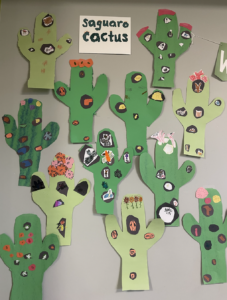This week’s habitat focus is the desert! Desert areas are areas of dry land with special plants and animals that can survive without much water. An area that gets less than 10 inches of rainfall per year is considered a desert. Desert biomes are found on every continent in the world and they cover one fifth of the land on Earth. First we are studying the dry and hot variety of desert. (Later this week, students will learn that Antarctica is actually the world’s largest desert!) At first, deserts might seem empty and barren, but first graders soon discovered they are full of life. Every plant and animal in the desert has its own way of surviving in the tough conditions.
Today we closely studied a specific type of desert plant and the animals that interact with it – the saguaro cactus. The saguaro cactus is like a bustling apartment complex for desert animals. Saguaros grow very slowly but live for a very long time. By age 50, they are typically about 10 feet tall and bloom for the first time. The saguaro’s flowers bloom at night, attracting pollinators like bees and bats, while its juicy fruits provide a tasty treat for birds and mammals alike. The nectar in their flowers attracts birds and insects, beginning a long symbiotic relationship with the animals of the desert. Birds, like the Gila woodpecker, often carve out cozy nests in its arms, while bats may roost during the day, emerging at night to hunt for insects. Inside the cactus, small creatures such as insects and rodents find refuge from the scorching sun and hungry predators. Even larger animals like coyotes and javelinas seek shelter under its branches. Over the next 100 years or so, many animals will live inside the walls of the cactus, benefitting from it. The cactus benefits too, as the birds that live there help eat insects that might have brought disease to the cactus. We learned about this process in a nonfiction book called Cactus Hotel by Brenda Z Guiberson. After reading, were lucky to be able to view some photos of an actual saguaro cactus that were shared with last year’s first grade class by one of their classmates, Eleanor. After learning about this desert plant and the animals that inhabit it, first graders created their own saguaro cacti from paper and filled it with animals that live in the saguaro cactus.






